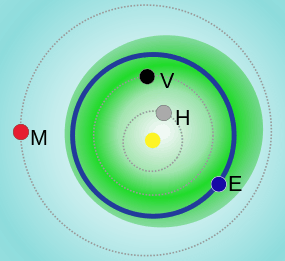2011 GA
2011 GA is a small asteroid that is a Near-Earth object and an Apollo asteroid.
| Discovery[1] | |
|---|---|
| Discovered by | Mount Lemmon Survey |
| Discovery site | Catalina Mountains north of Tucson, Arizona, USA |
| Discovery date | April 1, 2011 |
| Designations | |
| 2011 GA | |
| MPO 200327 | |
Apollo  NEO, PHA | |
| Orbital characteristics[2] | |
| Epoch 13 January 2016 (JD 2457400.5) | |
| Uncertainty parameter 5 | |
| Observation arc | 70 d |
| Aphelion | 2.8692 AU (429.23 Gm) |
| Perihelion | 0.73727 AU (110.294 Gm) |
| 1.80321 AU (269.756 Gm) | |
| Eccentricity | 0.59114 |
| 2.42 yr (884.44 d) | |
| 305.631° | |
| 0° 24m 25.33s /day | |
| Inclination | 9.8282° |
| 200.4246° | |
| 109.750° | |
| Earth MOID | 0.00686464 AU (1,026,936 km) |
| Jupiter MOID | 2.51622 AU (376.421 Gm) |
| Physical characteristics | |
| Dimensions | 170–380 m[3] |
| 21.0[2] | |
Orbit
The orbit of 2011 GA makes it a Potentially Hazardous Asteroid (PHA) that is predicted to pass within 0.02 AU (3,000,000 km; 1,900,000 mi) of the Earth on Oct 14, 2023.[4] For comparison, the distance to the Moon is about 0.0026 AU (384,400 km). The asteroid passed within 0.06 AU (9,000,000 km; 5,600,000 mi) from Earth around October 15, 1977.
The Jupiter Tisserand invariant, used to distinguish different kinds of orbits, is 3.821.[2]
gollark: But I can't actually figure out where I put it and my phone can do the same thing, so it's a bit limited in use.
gollark: I have a cheap 64GB USB stick from Toshiba or something for use as a live USB and stuff.
gollark: It makes sense for data you can't replace easily, I guess. But mostly I just have important stuff replicated onto multiple things.
gollark: Flash storage does seem to be generally pretty reliable as long as it doesn't break particularly soon or have some sort of horrible flaw, so I do now go for whatever's fairly cheap and has decent reviews. Obviously backups are important regardless of how reliable you assume your thing is.
gollark: I have a Samsung 250GB SSD from back when they were £80 or so, and it still works fine.
See also
References
- "2011 GA". Minor Planet Center. 10 June 2011.
- "JPL Small-Body Database Browser: (2011 GA)" (last observation: 2011-06-10; arc: 70 days). Jet Propulsion Laboratory. Retrieved 31 March 2016.
- "ABSOLUTE MAGNITUDE (H)". NASA.
- "JPL Small-Body Database Browser: (2011 GA) – Close-Approach Data". Jet Propulsion Laboratory. Retrieved 5 May 2015.
This article is issued from Wikipedia. The text is licensed under Creative Commons - Attribution - Sharealike. Additional terms may apply for the media files.


.jpg)